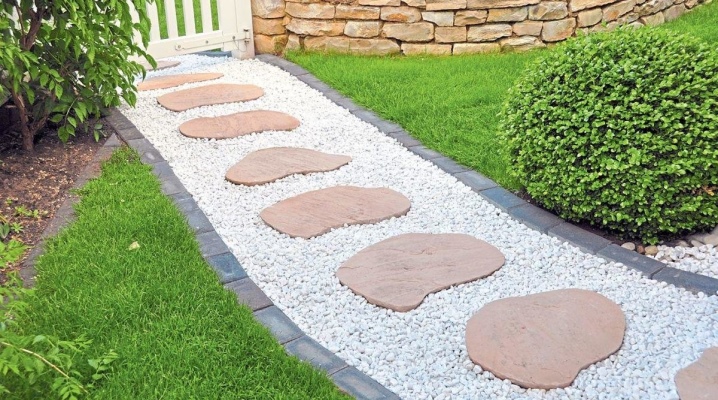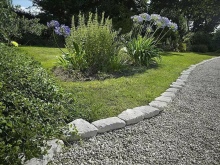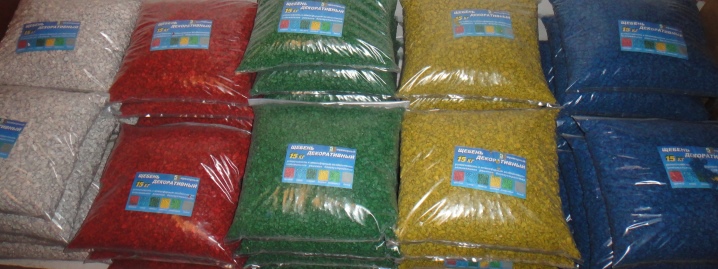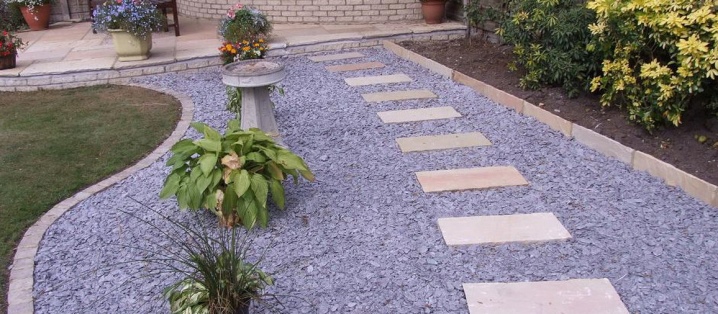Garden crushed stone

Crushed stone is a stylish, time-tested solution in landscape design. White decorative crushed stone will add aesthetics and sophistication to your garden area. In this article, we will consider not only it, but also other varieties, laying, staining and using crushed stone.

What it is?
Crushed stone is a bulk material used in construction and formed as a result of crushing hard rocks.
Crushed stone resembles small pebbles (1-3 cm), which are often stained for a garden plot.
The paint applied to the crushed stone is safe, does not contain toxic substances and is resistant to water, sunlight, low and high temperatures.



Crushed stone is a useful and practical material. Its advantages include:
-
application in the system of collection and removal of groundwater (drainage);
-
ensuring water balance;
-
protection against the growth of wild plants, weeds;
-
external characteristics.
The latter advantage allows landscape designers to use crushed stone to create the most unusual, interesting and eye-pleasing compositions involving flowers, shrubs and other plants.
The material allows water to quickly sink into the ground - this is very convenient if you want to make a small fountain or pond. And also crushed stone is used when decorating or laying paths. You can buy decorative stone at any hardware store.



What happens?
There are several types of decorative crushed stone. Their key difference is the stone from which the crushed stone is created. Its types:
-
dolomite (limestone);
-
granite;
-
quartz;
-
shale;
-
from a coil;
-
marble.
Let's take a closer look at them.


Dolomite is a white sedimentary rock. Crushed stone from this material varies in size from 3 to 7 cm. Dolomite crushed stone is less radioactive and absorbs water more strongly than granite.
Depending on the impurities, this type of crushed stone can be:
-
pure white,
-
yellow-white,
-
gray-white,
-
gray-blue.
Due to the prevalence of dolomite gravel, it is relatively inexpensive.


Crushed granite is a durable, frost-resistant material. Has a color range from gray to red. In size, such crushed stone can be both very small - 3-5 mm, and medium-sized - up to 7 cm, due to which it has a wide range of applications.

Quartz (quartzite) crushed stone is obtained from silica. Quartzite is a clean and environmentally friendly material that has no background radiation. It is particularly resistant to abrasion and frost resistance. Quartz crushed stone is usually white, less often yellow, ocher or gray. The processed smoky has a special charm.

Shale crushed stone is a material of volcanic origin. Its color palette includes shades: red, crimson, black, gray, green, yellow, brown. Shale crushed stone is more often used for laying paths. The shape of its fraction is flat, oblong.

Coil crushed stone (serpentinite) is a beautiful gray-green material. Its color, indeed, resembles a snake: a calm muted green tone, white, yellow and brown spots and stripes. Fraction size - 5-70 mm.

Marble is a luxurious, stylish and expensive material. It is durable, chemically passive, heat resistant.


Buy decorative crushed stone in bags. You can determine which crushed stone is best for your site, based on the following indicators:
-
frost resistance;
-
radioactivity;
-
strength (crushing);
-
composition and shape;
-
water permeability.

How is it applied?
There are quite a few ways to use decorative crushed stone, it all depends on the imagination of the customer or designer. Most often, crushed stone is used for:
-
registration;
-
framing;
-
dumping;
-
blind areas;
-
mulching;
-
tracks.


You can decorate both flower beds and individual garden zones, create compositions from flowers, bushes, bridges. With the help of crushed stone, you can easily and tastefully decorate a pond, a monument or other decor items with a frame.
Fine crushed stone can be used to decorate the yard without tiles - this is a great way to make smooth paths or paths for a summer residence.
Crushed stone comes to the rescue and in the filling of the site. The purpose of the method is to raise the ground level. Filling with gravel is needed in the following cases:
-
high groundwater level;
-
the need to create a drainage system;
-
alignment of the site;
-
for a new type of landscape.
-
To protect the building from excessive moisture or water, a blind area is created using clay, sand and gravel. The structure itself is a waterproof coating that runs along the perimeter of the house.

Another significant reason for using crushed stone for a summer cottage is mulching. It is great for covering plots of land to maintain plant health.

How to paint at home?
It is no secret that decorative (painted) crushed stone costs several times more in the store than do-it-yourself painted. A small amount of work allows you to finish painting in one to two days. Of the equipment you need a minimum of tools:
-
shovel;
-
gloves;
-
bucket;
-
spacious ejection container;
-
paint sprayer;
-
mesh with small cells.
The last element is necessary for drying and washing crushed stone.
Acrylic or polyacrylic are suitable as paint or enamel.


So, let's start painting by hand:
-
check the rubble for foreign particles such as plants or roots;
-
rinse with water;
-
dry;
-
place in a container (which is not a pity) for staining;
-
add paint, stir with a shovel, repeat the procedure several times;
-
dry the crushed stone by spreading it on a grid in a thin layer;
-
cover with a layer of paint from a spray gun several times from different sides;
-
dry.
The described method is suitable for gradually painting over the material in parts.
Granite and marble crushed stone is best suited for painting, dolomite is worse.

How to stack?
The way of laying the material is different for each structure. Consider the one that is used for decoration.
You don't need any special skills to lay the rubble yourself. For complete confidence, it is worth preparing the chosen place before laying.
Let's analyze all the stages of work.
-
Remove wild plants and topsoil (up to 10 cm).
-
Install the curb. It can be brick, wood or medium-sized stone. It must be firmly fixed.
-
Lay the sand evenly in a layer of 5-10 cm and sprinkle with water.
-
Spread out a second, even layer of 3 cm thick sand.
-
Make a drawing (or visible demarcation) of the place you are decorating. If you are using two or more types of crushed stone (for example, two different colors), and they should not be mixed, install internal curbs.
-
Lay the crushed stone in a layer 2 cm thick, if it is a path - 5 cm or more.
A simple and interesting way to arrange the laying of crushed stone is flagstone. Plants planted next to it or growing from behind a limestone border look unusual and beautiful in their own way.

Examples in landscape design
Nowadays decorative crushed stone is actively used in landscape design. Its advantages and affordability allow you to create interesting and memorable compositions. Let's look at some of them and start with the tracks.
Here, stone tiles are used, the same vertically arranged slabs as a border. They go well with a stone flower bed.Plants in pots are placed in a line parallel to the path along the area - it looks very impressive.

An interesting track turned out with white rubble. Here, a stone curb and densely planted grass in a curved line act as restrictions. "Spots" of bare soil left for plants look like small flower beds.

This path is in oriental style. It has no curb and is smoothly overgrown with grass. It is pleasant and interesting to walk on such stone slabs.

Flaky (flat) crushed stone was used in this composition. It is interesting in that it is not a simple, but a multilevel path. The ladder is decorated with wood inserts (probably dug in to hold the masses), moss and undersized spruce.

Here, the entire land space is covered with gravel. Smooth stone slabs are in harmony with the shape of the flower bed and the line of planting trees - everything reminds of geometry.

Beautiful composition with flowers - when creating this flower bed, crushed stone of two sizes and colors was used, which gives it sophistication and sophistication. Plants are clearly visible on a white background, the area of each of them is bordered by a red ribbon.

Unusual geometric flower bed.

Crushed stone, located with "spots" or patterns, looks creative and always fresh.


Here the author showed his imagination, replacing the stream with blue rubble.

In the decoration of this fountain, the most common gravel was used: but how beautifully it fits into the design!

Photo, obviously, of the same garden: rubble under water. To achieve this result, you will need to lay a protective layer from the ground.


How to refine the site with rubble, see the video.













The comment was sent successfully.